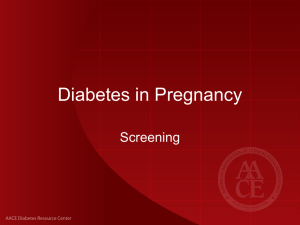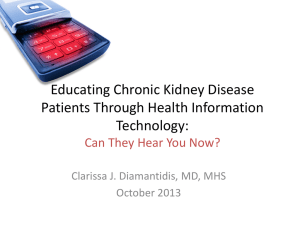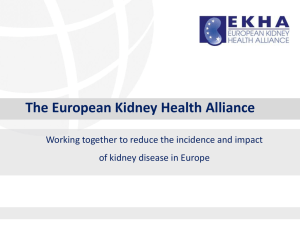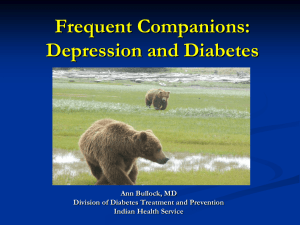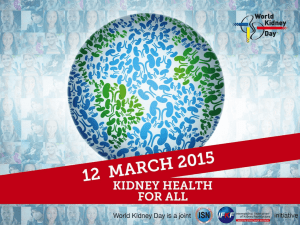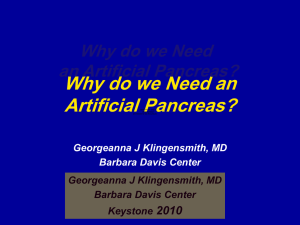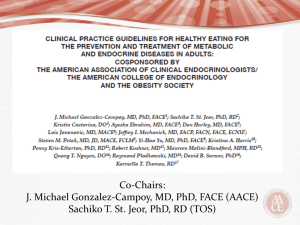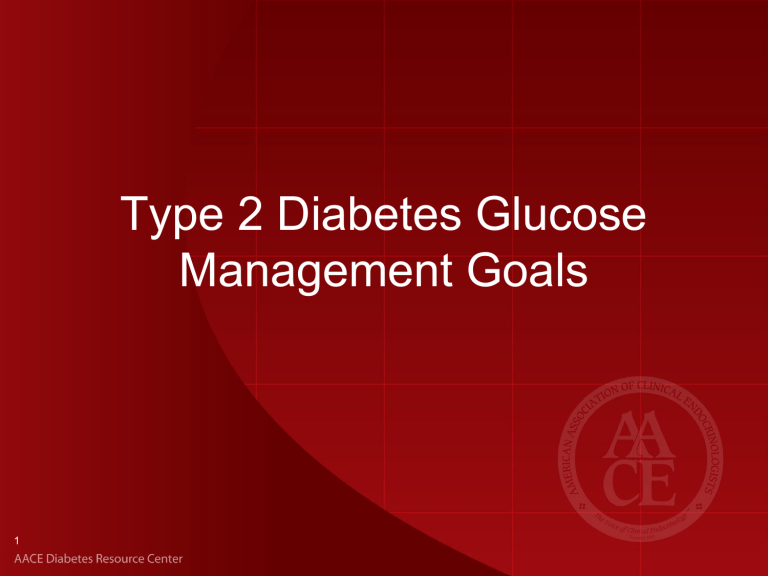
Type 2 Diabetes Glucose
Management Goals
1
AACE Comprehensive
Diabetes Care: Glucose Goals
Parameter
Treatment Goal for Nonpregnant Adults
A1C (%)
Individualize based on age, comorbidities, and
duration of disease*
• ≤6.5 for most
• Closer to normal for healthy
• Less stringent for “less healthy”
FPG (mg/dL)
<110
2- hour PPG (mg/dL)
<140
*Considerations include
•
•
•
2
Residual life expectancy
Duration of T2DM
Presence or absence of
microvascular and macrovascular
complications
•
•
•
•
CVD risk factors
Comorbid conditions
Risk for severe hypoglycemia
Patient’s psychological, social,
and economic status
Handelsman Y, et al. Endocr Pract. 2011;17(suppl 2):1-53.
Well-Recognized Risks for
Hypoglycemia in T2DM
• Use of insulin secretagogues and insulin therapy in any of
the following settings:
–
–
–
–
–
–
–
–
Missed or irregular meals
Advanced age
Longer duration of diabetes
Impaired awareness of hypoglycemia
Exercise
Taking greater than the prescribed medication dose
Excessive alcohol intake
Preexisting impairment, or sudden worsening, of renal or
hepatic function
• Less well-recognized risks: female sex, African-American
race, less education (ACCORD)
3
Amiel SA, et al. Diabet Med. 2008;25:245-254.
ADA. Diabetes Care. 2005;28:1245-1249.
Limitations of Management Goals:
Potential Consequences of Hypoglycemia
• Neurogenic symptoms
– Tremor, palpitations, anxiety, sweating, hunger (weight gain),
paresthesias
• Neuroglycopenia morbidity
– Cognitive impairment, psychomotor abnormalities, abnormal
behavior, seizure, coma, mortality (brain death)
• Rebound hyperglycemia, brittle diabetes
• Barrier to glycemic control and adherence to treatment
secondary to fear of hypoglycemia
• Greater risk of dementia
• Prolonged QT interval with increased risk of dysrhythmias,
sudden death
• Harm to property or to others (eg, if driving)
4
Cryer PE. J Clin Invest. 2007;117:868-870.
Cryer PE. Diabetes Care. 2003;26:1902-1912.
Glucose Control and Mortality:
ACCORD Posthoc Analysis
Adjusted Log (Hazard Ratio) by Treatment Strategy
Relative to Standard at A1C of 6%
Mortality Risk
Intensive
Risk increase with each
1% increase in A1C
Log (Hazard Ratio)
P Value
1
66%
<0.0001
0
14%
0.17
Standard
-1
Mortality Benefit
6
7
8
Average A1C (%)
9
5
Riddle MC, et al. Diabetes Care. 2010;33:983-990.
Algorithm for Individualizing
Glycemic Targets
Most intensive
6.0%
Less intensive
7.0%
Least intensive
8.0%
Psychosocioeconomic considerations
Less motivated, nonadherent, limited
insight, poor self-care capacities, and
weak support systems
Highly motivated, adherent, knowledgeable,
excellent self-care capacities, and
comprehensive support systems
Hypoglycemia risk
Moderate
High
Low
40
45
5
None
None
6
50
55
60
10
Few or mild
65
Patient age, years
70
75
15
Disease duration, years
20
Other comorbid conditions
Multiple or severe
Established vascular complications
Cardiovascular disease
Early microvascular
Advanced microvascular
Ismail-Beigi F, Moghissi E, et al. Ann Intern Med. 2011;154:554-559.
ADA-Recommended Approach to
Management of Hyperglycemia
More Stringent
Less Stringent
Patient attitude and expected treatment
efforts Highly motivated, adherent,
excellent self-care capacities
Less motivated, nonadherent,
poor self-care capacities
Risks potentially associated with
hypoglycemia, other adverse events Low
Disease duration
Life expectancy
Important comorbidities
Established vascular complications
Resources, support system
High
Newly diagnosed
Long-standing
Long
Short
Absent
Few/mild
Severe
Absent
Few/mild
Severe
Readily available
Limited
7
Inzucchi SE, et al. Diabetes Care. 2012;35:1364-1379.
Hyperglycemia and
Microvascular Complications
8
Hyperglycemia-Induced Tissue
Damage: General Features
Genetic determinants of
individual susceptibility
Repeated acute
changes in cellular
metabolism
Diabetic tissue
damage
Hyperglycemia
Cumulative long-term
changes in stable
macromolecules
Independent
accelerating factors
(eg, hypertension,
dyslipidemia)
9
Brownlee M. Diabetes. 2005;54:1615-1625.
Microvascular Complications
of Diabetes
Nephropathy
10
Retinopathy
Neuropathy
Microvascular Complications
Increase With Increasing A1C
Diabetes Control and Complications Trial
20
Retinopathy
18
Nephropathy
Relative Risk
16
Neuropathy
14
Microalbuminuria
12
10
8
6
4
2
0
6
7
8
9
A1C (%)
10
11
12
11
Skyler JS. Endocrinol Metab Clin North Am. 1996;25:243-254.
Reducing A1C Reduces
Microvascular Risk
Microvascular Complications
Hazard Ratio
United Kingdom Prospective Diabetes Study
10
P<0.0001
1
37% Decrease
per 1% reduction in A1C
0.5
0 5
6
7
8
9
10
Updated Mean A1C
12
Stratton IM, et al. BMJ. 2000;321:405-412.
Reducing A1C Reduces
Nephropathy Risk in T2DM
13
UKPDS
ADVANCE
ACCORD
A1C reduction (%)*
0.9
0.8
1.3
Nephropathy risk
reduction (%)*
30
21
21
New
onset
microalbuminuria
(P=0.033)
New or
worsening
nephropathy
(P=0.006)
New
microalbuminuria
(P=0.0005)
*Intensive vs standard glucose control.
1. UK Prospective Diabetes Study (UKPDS) Group. Lancet. 1998;352:837-853.
2. ADVANCE Collaborative Group. N Engl J Med. 2008;358:2560-2572.
3. Ismail-Beigi F, et al. Lancet. 2010;376:419-430.
Prevalence of CKD in
Diagnosed Diabetes
Diabetic Kidney Disease Is the Leading Cause of Kidney Failure in the United States
Stage 1;
10,4%
NKF
Description
Stage
Stage 2;
13,4%
No kidney
disease;
60,4%
Stage 3;
14,1%
GFR
1
Kidney damage* with
normal or GFR
≥90
2
Kidney damage* with
mild GFR
60-89
3
Moderate GFR
30-59
4
Severe GFR
15-29
5
Kidney failure or
ESRD
<15 or
dialysis
Stage 4;
1,1%
14
*Pathologic abnormalities or markers of damage, including abnormalities in blood or urine tests or imaging studies.
ESRD, end-stage renal disease; GFR, glomerular filtration rate (mL/min/1.73 m2); NKF, National Kidney Foundation.
CDC. National diabetes fact sheet, 2011. http://www.cdc.gov/diabetes/pubs/pdf/ndfs_2011.pdf.
Plantinga LC, et al. Clin J Am Soc Nephrol. 2010;5:673-682.
Development of
Diabetic Nephropathy
Hyperglycemia
Hyperfiltration
Hypertension
Enlarged
kidneys
Angiotensin II
Breakdown of
glomerular
filtration barrier
Microalbuminuria
Genetically susceptible individuals
Protein
reabsorption and
accumulation in
renal epithelial
cells
Capillary
occlusion
Decreasing
GFR
Macroalbuminuria
Release of
vasoactive and
inflammatory
cytokines
Tubule and
podocyte
damage
Tubular atrophy
and fibrosis,
podocyte
destruction
Renal
failure
15
Radbill B, et al. Mayo Clin Proc. 2008;83:1373-1381.
Remuzzi G, Bertani T. N Engl J Med. 1998;339:1448-1456.
CV Risk Increases With
Comorbid Diabetes and CKD
Incidence per 100 Patient-Years
No diabetes/no CKD
Diabetes/CKD
60
x 2.8
x 2.0
50
40
30
x 2.1
x 1.7
x 2.5
20
10
x 2.3
0
CHF
16
Diabetes/no CKD
AMI
CVA/TIA
PVD
ASVD*
Death
AMI, acute myocardial infarction; ASVD, atherosclerotic vascular disease; CHF, congestive heart failure;
CVA/TIA, cerebrovascular accident/transient ischemic attack; PVD, peripheral vascular disease.
*ASVD was defined as the first occurrence of AMI, CVA/TIA, or PVD.
Foley RN, et al. J Am Soc Nephrol. 2005;16:489-495.
Appropriate Staging and
Management of DKD
GFR
Stage Description
Action*
Diagnose and treat CKD, slow
progression of CKD, treat comorbid
conditions, reduce CVD risk factors
1
Kidney damage† with
normal or GFR
≥90
2
Kidney damage† with
mild GFR
60-89
Estimate progression
3
Moderate GFR
30-59
Evaluate and treat complications
4
Severe GFR
15-29
Prepare for kidney replacement
therapy
5
Kidney failure
ESRD
17
(mL/min/1.73 m2)
<15 or dialysis
Kidney replacement, if uremia
present
Renal replacement therapy
DKD, diabetic kidney disease.
*Includes actions from preceding stages.
†Pathologic abnormalities or markers of damage, including abnormalities in blood or urine tests or imaging studies.
National Kidney Foundation. Am J Kidney Dis. 2002;39(suppl 1):S1-S266.
KDIGO CKD Classification by
Relative Risk
Albuminuria stages (mg/g)
A3
Optimal and high
normal
High
Very high and
nephrotic
10-29
30-299
300-1999
≥2000
Very low
Very low
Low
Moderate
Very high
Very low
Very low
Low
Moderate
Very high
Mild to
45-59
moderate
Low
Low
Moderate
High
Very high
Moderate
30-44
to severe
Moderate
Moderate
High
High
Very high
High
High
High
High
Very high
Very high
Very high
Very high
Very high
Very high
High and
optimal
G2
Mild
G5
A2
<10
G1
GFR
stages
(mL/min G3a
per 1.73
m2 body
surface G3b
area)
G4
A1
>105
90-104
75-89
60-74
Severe
15-29
Kidney
failure
<15
18
Levey AS, et al. Kidney Int. 2011;80:17-28.
DKD Risk Factor Management
Risk Factor
Goal
Hyperglycemia
Individualized A1C goals Avoid biguanide in moderate to severe CKD
≤6.5% for most (AACE) Consider need for dose reductions and/or risk of
hypoglycemia and other renal-related AEs with other
<7.0% (NKF)
antidiabetic agents
Hypertension
BP <130/80 mmHg
Proteinuria
Dyslipidemia
Management Recommendation
Use ACE inhibitor or ARB in combination with other
antihypertensive agents as needed
Use ACE inhibitor or ARB as directed
LDL-C <100 mg/dL,
<70 mg/dL an option for
high risk
Statin therapy recommended
Fibrate dose reduction may be required
19
Handelsman Y, et al. Endocr Pract. 2011;17(suppl 2):1-53.
National Kidney Foundation. Am J Kidney Dis. 2007;49(suppl 2):S1-S179.
Use of Noninsulin Antidiabetic
Therapies in Patients With Kidney
Disease
20
Class
Agent(s)
Kidney Disease Recommendation
Amylin analog
Pramlintide
No dosage adjustment
Thiazolidinediones
Pioglitazone, rosiglitazone
No dosage adjustment
Bile acid sequestrant
Colesevelam
No dosage adjustment
DPP-4 inhibitors
Linagliptin, saxagliptin, sitagliptin
Dopamine-2 agonist
Bromocriptine
Glinides
Nateglinide, repaglinide
Insulin
Aspart, detemir, glargine, glulisine, lispro, NPH,
regular
Sulfonylureas
Glimepiride, glipizide, glyburide
GLP-1 receptor agonists
Exenatide, exenatide XR, liraglutide
-Glucosidase inhibitors
Acarbose, miglitol
Biguanide
Metformin
Reduce dosage for saxagliptin and
sitagliptin if CrCl <50 mg/dL
Use with caution
Use lowest effective dose of nateglinide
for stage ≥3 CKD
Dosage reduction needed in
stage 4-5 CKD
Glimepiride preferred, use lowest
effective dose; avoid other SUs
Use with caution in stage 3 CKD;
avoid in stage 4-5 CKD
Not recommended if SCr >2 mg/dL;
avoid in dialysis
Contraindicated if SCr >1.5 in men or
1.4 in women
Inzucchi SE, et al. Diabetes Care. 2012;35:1364-1379.
Handelsman Y, et al. Endocr Pract. 2011;17(suppl 2):1-53.
National Kidney Foundation. Am J Kidney Dis. 2007;49(suppl 2):S1-S179.
Dietary Guidelines for DKD
CKD Stage
Macronutrient
1-2
1-4
Sodium
<2.3
Total fat, % calories*
<30
Saturated fat, % calories
<10
Cholesterol, mg/day
<200
Carbohydrate, % calories
50-60
Protein, g/kg/day (% calories)
3-4
0.8 (~10)
0.6-0.8 (~8-10)
Phosphorus
1.7
0.8-1.0
Potassium
>4
2.4
*Adjust so total calories from protein, fat, and carbohydrate are 100%.
Emphasize such whole-food sources as fresh vegetables, whole grains, nuts, legumes, low-fat or
nonfat dairy products, canola oil, olive oil, cold-water fish, and poultry.
Tailor dietary counseling to cultural food preferences.
21
Handelsman Y, et al. Endocr Pract. 2011;17(suppl 2):1-53.
National Kidney Foundation. Am J Kidney Dis. 2007;49(suppl 2):S1-S179.
Reducing A1C Reduces Retinopathy
Progression in T2DM
A1C reduction (%)
Retinopathy risk
reduction (%)*
22
UKPDS
ACCORD
0.9
1.3
29
17
33
Retinopathy
onset
(P=0.003)
Retinopathy
progression
(P=0.017)
Retinopathy
progression
(P=0.003)
*Intensive vs standard glucose control.
UK Prospective Diabetes Study (UKPDS) Group. Lancet. 1998;352:837-853.
Ismail-Beigi F, et al. Lancet. 2010;376:419-430.
Chew EY, et al. N Engl J Med. 2010;363:233-244.
Prevalence of Diabetic
Retinopathy
Diabetic Retinopathy Is the Leading Cause of Adult Blindness in the United States
NHANES 2005-2008
Adults Age ≥40 Years (N=1006)
None; 71,5%
Visionthreatening*;
4,4%
NPDR; 24,1%
23
*Severe NPDR, PDR, or clinically significant macular edema.
NPDR, nonproliferative diabetic retinopathy; PDR, proliferative diabetic retinopathy; T2DM, type 2 diabetes mellitus.
CDC. National diabetes fact sheet, 2011. http://www.cdc.gov/diabetes/pubs/pdf/ndfs_2011.pdf.
Zhang X, et al. JAMA. 2010;304:649-656.
Diabetic Retinopathy
Management
• Goal: detect clinically significant retinopathy before vision is threatened
• Annual dilated eye examination by experienced ophthalmologist,
starting at diagnosis for all T2DM patients
Lesion Type
Management Recommendation
Background or
•
nonproliferative retinopathy
Optimal glucose and blood pressure control
Macular edema
•
•
•
Optimal glucose and blood pressure control
Ranibizumab injection therapy
Focused laser photocoagulation guided by fluorescein
angiography
Preproliferative retinopathy
•
•
Optimal glucose and blood pressure control
Panretinal scatter laser photocoagulation
Proliferative retinopathy
•
•
•
Optimal glucose and blood pressure control
Panretinal scatter laser photocoagulation
Vitrectomy for patients with persistent vitreous
hemorrhage or significant vitreous scarring and debris
24
Handelsman Y, et al. Endocr Pract. 2011;17(suppl 2):1-53.
Reducing A1C Reduces
Neuropathy Risk in T2DM
ACCORD
A1C reduction (%)
1.3
Neuropathy risk
reduction (%)*
12
Loss of sensation to
light touch
(P=0.045)
25
*Intensive vs standard glucose control.
Ismail-Beigi F, et al. Lancet. 2010;376:419-430.
Prevalence of Diabetic Neuropathy
Diabetic Peripheral Neuropathy Is the Leading
Cause of Nontraumatic Amputations in the United States
NHANES 1999-2004
Adults With Diabetes, Age ≥40
(N=559)
Years3
•
Neuropathy is a heterogenous
disorder
•
70% to 100% of T2DM patients may
have at least mild damage to
DPN;
18,5%
– Proximal nerves
– Distal nerves
– Somatic nerves
– Autonomic nerves
•
Neuropathy may be
– Acute and self-limiting
– Chronic and indolent
None;
81,5%
26
CDC. National diabetes fact sheet, 2011.
http://www.cdc.gov/diabetes/pubs/pdf/ndfs_2011.pdf.
Gregg EW, et al. Diabetes Res Clin Pract. 2007;77:485-488.
Handelsman Y, et al. Endocr Pract. 2011;17(suppl 2):1-53.
Diabetic Neuropathies: Key Characteristics and
Management Recommendations
• Optimize glucose, lipid, and blood pressure control for all T2DM patients
Type
Condition(s)
Clinical Features
Focal
Mononeuritis
Single nerve involvement
Inflammatory demyelinating
conditions
Entrapment
Carpal tunnel syndrome
Proximal lumbosacral
Thoracic
Cervical radiculoplexus
neuropathies involving the
proximal limb girdle
Treatment
Immunotherapy
27
Handelsman Y, et al. Endocr Pract. 2011;17(suppl 2):1-53.
Diabetic Neuropathies: Key Characteristics and
Management Recommendations
• Optimize glucose, lipid, and blood pressure control for all T2DM patients
Type
Condition(s)
Clinical Features
Treatment
Large-fiber sensorimotor
polyneuropathy
Symmetric, glove and stocking
distribution with
Loss of sensation
Poor coordination
Ataxia
Low-impact activities that improve
muscular strength and coordination and
challenge the vestibular system
Pilates
Yoga
Tai Chi
Symmetric, glove and stocking
distribution with
Loss of sensation
Pain
Autonomic features
Protect insensate feet from ulceration
Padded socks
Daily inspection by patient
Moisturizing lotions
Treat neuropathic pain
Amitriptyline
Gabapentin
Pregabalin
Duloxetine
Topical lidocaine
Distal
neuropathy
Small-fiber neuropathy
28
Handelsman Y, et al. Endocr Pract. 2011;17(suppl 2):1-53.
Diabetic Neuropathies: Key Characteristics and
Management Recommendations
• Optimize glucose, lipid, and blood pressure control for all T2DM patients
Type
Condition(s)
Clinical Features
Treatment
Autonomic
Cardiac
Symptoms
Tachycardia
Exercise intolerance
Orthostatic hypotension, weakness,
fatigue, syncope
Associated with significant mortality and
possibly also
Silent myocardial ischemia
Coronary artery disease
Stroke
Diabetic nephropathy progression
Perioperative morbidity
Intensive control of CV risk factors
For tachycardia, exercise intolerance
Supervised exercise
ACE inhibitors
-adrenergic blockers
For hypotension, weakness, etc
Mechanical measures
Clonidine
Midodrine
Octreotide
Erythropoietin
29
Handelsman Y, et al. Endocr Pract. 2011;17(suppl 2):1-53.
Diabetic Neuropathies: Key Characteristics and
Management Recommendations
• Optimize glucose, lipid, and blood pressure control for all T2DM patients
Type
Condition(s)
Clinical Features
Treatment
Autonomic
Gastrointestinal
Gastroparesis, erratic glucose control
Frequent small meals
Prokinetic agents
Metoclopramide
Domperidone
Erythromycin
Abdominal pain, early satiety,
nausea, vomiting, bloating, belching
Antibiotics
Antiemetics
Bulking agents
Constipation
High-fiber diet
Bulking agents
Osmotic laxatives
Lubricating agents
Diarrhea (often nocturnal, alternating
with constipation)
Soluble dietary fiber
Gluten and lactose
restriction
Anticholinergic agents
Tricyclic
antidepressants
Pyloric Botox
Gastric pacing
Cholestyramine
Antibiotics
Somatostatin
Pancreatic enzyme
supplements
30
Handelsman Y, et al. Endocr Pract. 2011;17(suppl 2):1-53.
Diabetic Neuropathies: Key Characteristics and
Management Recommendations
• Optimize glucose, lipid, and blood pressure control for all T2DM patients
Type
Condition(s)
Clinical Features
Treatment
Autonomic
Sexual dysfunction
Erectile dysfunction
Sex therapy
Psychological counseling
5′-phosphodiesterase inhibitors
Prostaglandin E1 injections
Devices
Prostheses
Vaginal dryness
Vaginal lubricants
Bladder dysfunction Frequency, urgency, nocturia, urinary
retention, incontinence
Bethanechol
Intermittent catheterization
Sudomotor
dysfunction
Emollients and skin lubricants
Scopolamine
Glycopyrrolate
Botulinum toxin
Vasodilators
Anhidrosis
Heat intolerance
Dry skin
Hyperhidrosis
31
Handelsman Y, et al. Endocr Pract. 2011;17(suppl 2):1-53.
Hyperglycemia and
Macrovascular Complications
32
7-Year Incidence of MI (%)
Diabetes Is a Cardiovascular
Disease Risk Equivalent
P<0.001
50
45
40
30
P<0.001
18,8
20,2
Prior MI
No prior MI
20
10
3,5
0
No prior MI
Nondiabetic
(n=1373)
33
Prior MI
Diabetic
(n=1059)
MI, myocardial infarction.
Grundy SM, et al. Circulation. 2004;110:227-239.
Haffner SM, et al. N Engl J Med. 1998;339:229-234.
Lower A1C Is Associated With Lower
Risk of Myocardial Infarction
United Kingdom Prospective Diabetes Study
Myocardial Infarction
Hazard Ratio
10
P<0.0001
1
14% Decrease
per 1% reduction in A1C
0.5
0 5
6
7
8
9
10
Updated Mean A1C
34
Stratton IM et al. BMJ. 2000;321:405-412.
Intensive Glycemic Control Reduces
Long-term Macrovascular Risk in Younger
Patients With Shorter Duration of Disease
UKPDS
T2DM, newly diagnosed (N=4209)
DCCT
T1DM, 5-6 years duration (N=1441)
42% risk reduction
0.10
0.08
Conventional
Randomized
treatment
0.06
0.04
0.02
P=0.01
1.0
Proportion With MI
0.12
CV Outcome
Cumulative incidence
15% risk reduction
P=0.02
Intensive
0.00
0.8
0.6
Randomized
treatment
0.4
0.2
Intensive
0.0
0
5
10
15
20
0
5
No. at Risk
Conventional
Intensive
714
705
688
683
10
15
20
25
221
577
20
66
Years
Years
35
Conventional
618
629
92
113
1138
2729
1013
2488
857
2097
578
1459
CV, cardiovascular; DCCT, Diabetes Control and Complications Trial; MI, myocardial infarction;
UKPDS, United Kingdom Prospective Diabetes Study.
Nathan DM, et al. N Engl J Med. 2005;353:2643-2653.
Holman RR, et al. N Engl J Med. 2008;359:1577-1589.
Intensive Glycemic Control Does Not
Reduce Macrovascular Risk in Older
Patients With Longer Duration of Disease
ACCORD
ADVANCE
VADT
T2DM duration (years)
10
8
12
A1C reduction (%)*
0.9
0.8
1.3
Macrovascular risk
(%)*
10
6
12
P=0.16
P=0.32
P=0.14
Mortality
increased in
intensively
treated patients
(P=0.04)
36
*Intensive vs standard glucose control.
ACCORD Study Group. N Engl J Med. 2008;358:2545-2559.
ADVANCE Collaborative Group. N Engl J Med. 2008;358:2560-2572.
Duckworth W, et al. N Engl J Med. 2009;360:129-139.
Macrovascular Risk Reduction
in T2DM
•
•
•
•
•
•
Individualized glucose control
Hypertension control
Dyslipidemia control
Smoking cessation
Aspirin therapy
Diagnosis and management of:
– Autonomic cardiac neuropathy
– Kidney disease
37
Handelsman Y, et al. Endocr Pract. 2011;17(suppl 2):1-53.


